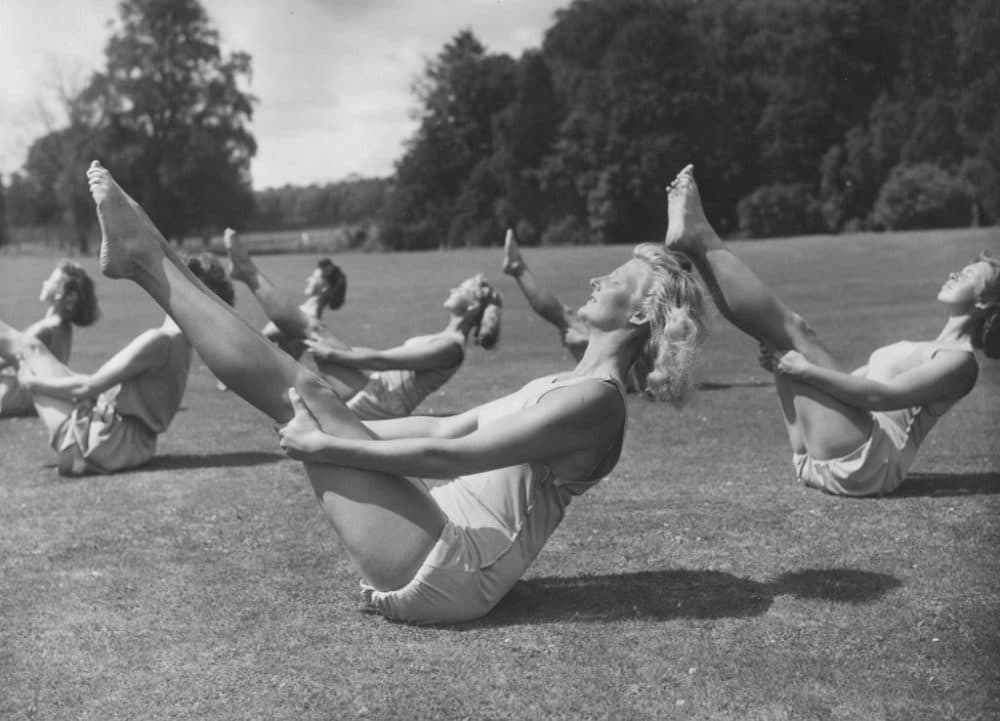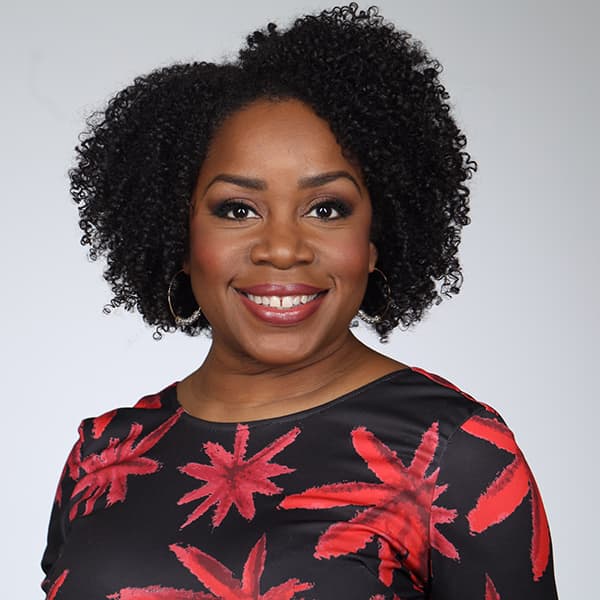Advertisement
The complicated history of women's fitness

Personal fitness for women used to be considered unladylike.
That all changed with fitness pioneers like Lotte Berk and Judi Sheppard Missett.
But look closer and there’s much more to the story than jazz shoes and leg warmers.
Today, On Point: The history of women’s fitness, and the next turning point for women’s relationship with fitness.
Guests
Danielle Friedman, journalist and author. Author of "Let's Get Physical." (@DFriedmanWrites)
Jessica Rihal, plus-size yoga instructor, fitness and wellness advocate. (@jessicajadeyoga)
Interview Highlights
On Lotte Berk, the inventor of Barre
Danielle Friedman: “Lotte Berk was a German dancer. She was a refugee in London in the 1950s. And Lotte was pretty radical. Because at that time, in the U.K., as in the U.S., strenuous exercise for women was really considered pretty taboo. Sweat was considered unladylike. But Lotte had this vision of creating a workout that would allow women to become strong, allow women to actually connect with their sexuality.
"She was sort of a forerunner to the sexual revolution. But she also promised women, you know, dancers' bodies. And so from really the beginning of the contemporary fitness industry, the promise of strength and the promise of cosmetic transformation were really intertwined. And I saw that reflected 70 years later in my class.”
On how Lotte Berk represents the complicated place women's fitness had in American culture
Danielle Friedman: “When I started researching Lotte, which led me to this larger history of women's fitness and a history that I was really surprised to find actually hadn't been told and in a sort of cohesive way before. On one hand, I discovered that the rise of women's fitness had provided a path to physical strength, and physical confidence and competence for millions of women. And I felt that that was a history that deserved to be celebrated.
"But as you say, at the same time as exercise became more accepted for women, it also became more expected of women. And with more opportunities, came increasingly greater pressures throughout the 20th century and then into the 21st century for women to meet an increasingly unrealistic beauty and body ideal. And so I was really interested in exploring how fitness, culture and beauty and diet culture for women kind of became so intertwined and how we can begin to unravel those cultures.”
On how the media has historically discussed exercise
Danielle Friedman: “My book begins in the 1950s, which was actually a low point for physical activity for both men and women. It was the post-World War II era. And after decades of tumult with the Great Depression and the war, America really put a premium on leisure and comfort. That's when we saw modern appliances enter the kitchen. TV really took off.
"So it was sort of considered a bit unusual for both men and women to embark on a formal exercise program at that time. But as the country began to gradually come around to and learn about the benefits of exercise, for women, it was a much, much tougher sell. You know, in that era, as you said, it was an era of really strict gender norms. When women who had maybe been sent to work, who had gone to work in the factory during the war were told to go home and to kind of restore the proper social order.
"They were told to behave quote 'like women,' which often meant sort of performing weakness, pretending you couldn't open the pickle jar. Women's magazines advised women to always let men win in games. So the early fitness evangelists and women's fitness evangelists at that time really faced a major uphill battle. One of the first, Bonnie Prudden, who I write about ... she was one of the earliest TV fitness gurus. And one of the first to really encourage women to embark on movement that would help them to become strong.
Advertisement
"She realized that selling strength for strength sake at that time to women would have never gone over. And so she pretty savvily packaged exercise as a beauty tool. She liked to say, under every curve, there's a muscle. No muscle, no curve. And so, yeah, she recognized that in order for it to be acceptable, she would have to sort of disguise it as something else. But she really unleashed what later became something of a monster.”
On unrealistic body standards in fitness
Danielle Friedman: “The real shame is that we know now from research that movement and fitness can hold tremendous benefits for women, not only for our physical health, but for our mental health and our emotional health. But ... from the beginning of the industry, those benefits were tainted by feelings of guilt and shame and pressure. And you know, I think when you hold up Jane Fonda as an ideal, Jane Fonda's body was sort of unrealistic even for Jane Fonda.
"She has written about how she had to go to extreme measures to achieve that body. But what this has meant is that historically, so many women have felt uncomfortable in fitness environments and have felt turned away and have felt that their body needs to be a constant project. That we should always be working on our bodies to kind of meet this completely unrealistic ideal. And thankfully we are, I think, at the beginning of a shift where we're starting to change that narrative a bit.”
On fitness in the 21st century
Danielle Friedman: “In the early 21st century was when we saw the rise of the real explosion of boutique studios, and luxury gyms and fitness sort of became almost an acceptable form of conspicuous consumption. But I really kind of have to point the finger at millennials, of which I am one. Who took fitness and turned it into this quest for kind of optimization ... always striving for something kind of harder, faster, better. And then there was the rise of social media as well, which added a whole other kind of performative aspect to fitness.
"So a trend that we've seen really from the birth of the contemporary industry in the 1950s is just this ratcheting up of what fitness has to mean. And that partaking in it can't just be going for a walk around the block. It has to be really investing in and committing to this whole way of life that involves a uniform and expensive memberships. And that has served to exclude a lot of people from participating.”
On changing the narrative in fitness
Jessica Rihal: “Because of social media, because people like you and me are curating what we want to see, and in that we're reflecting ourselves in that. So it is still a thing is still rampant, still an issue. It's still a struggle and a battle. But I think it's less meaningful than it was in the early 2000s, in the ‘90s and prior. Just because we have access to curate how we're marketed to what we see, to an extent more than ever before. And that, I think, is where we're getting the momentum to start having these conversations about changing that narrative.”
Book Excerpt
From Danielle Friedman's 'Let's Get Physical: How Women Discovered Exercise and Reshaped the World'
When popular media have explored the historical significance of women’s fitness culture, they have mostly treated it as a collection of disparate fads with little impact on women’s lives or society at large. It is often covered as kitsch—reminders of a past that women would just as soon forget, from vibrating belts that promised to eviscerate fat to neon leg warmers.
We can always find reasons to laugh at the choices made by our younger, less wise selves or forebearers—thong leotards? really?— but this popular treatment also surely stems from the fact that we live in a culture that diminishes women’s interests as silly and trivial. Dismissing the things women say they love as inconsequential allows our culture to stealthily ensure women remain subordinate to men.
American women’s fitness history is more than a series of misguided “crazes.” It’s the story of how women have chosen to spend a collective billions of dollars and hours in pursuit of health and happiness. In many ways, it’s the story of what it has meant to be a woman over the past seven decades.
For much of the twentieth century, most women didn’t move very much. They grew up being told they were physically limited. “For centuries women have been shackled to a perception of themselves as weak and ineffectual,” Colette Dowling writes in The Frailty Myth. “This perception has been nothing less than the emotional and cognitive equivalent of having our whole bodies bound.”
By the late sixties, however, women began to question whether they really were defined by their biology. A new wave of feminists wondered: What if women weren’t born physically weak, but became weak in a kind of self-fulfilling prophecy? After all, little boys were encouraged to climb trees and throw balls, while little girls were rewarded for displaying poise and grace. Boys were encouraged to get dirty; girls, to keep their clothes pristine. Even clothes themselves discouraged movement: The restrictive dresses, girdles, and high heels of mid-century women’s wardrobes made it difficult for them to bend, stretch, run, and sometimes even breathe.
Men enjoyed a lifetime of practicing how to use and trust their bodies; women did not.
In the early seventies, the authors of the seminal women’s health guide Our Bodies, Ourselves wrote: “Our bodies are the physical bases from which we move out into the world,” but “ignorance, uncertainty—even, at worst, shame—about our physical selves create in us an alienation from ourselves that keeps us from being the whole people that we could be. Picture a woman trying to do work and to enter into equal and satisfying relationships with other people . . . when she feels physically weak because she has never tried to be strong.”
The rise of women’s fitness offered a path to this strength.
For most of her life, the feminist icon Gloria Steinem actively avoided exercise, feeling more comfortable living in her head. “I come from a generation who didn’t do sports. Being a cheerleader or drum majorette was as far as our imaginations or role models could take us,” she wrote in her book Moving Beyond Words. “That’s one of many reasons why I and other women of my generation grew up believing—as many girls still do—that the most important thing about a female body is not what it does but how it looks. The power lies not within us but in the gaze of the observer.”
As she watched friends begin to exercise in the seventies and eighties, her perspective shifted. “For women to enjoy physical strength is a collective revolution,” Steinem later wrote. “I’ve gradually come to believe that society’s acceptance of muscular women may be one of the most intimate, visceral measures of change,” she also observed. “Yes, we need progress everywhere, but an increase in our physical strength could have more impact on the everyday lives of most women than the occasional role model in the boardroom or in the White House.”
Steinem herself began practicing yoga and lifting weights in her fifties.
Of course, women’s fitness culture is far from universally empowering. As this book will make clear, it is deeply intertwined with beauty culture, which sells the idea that women must change to be lovable—or even acceptable. Over the decades, fitness purveyors promising to lift women up have instead held them back and held them down by exploiting their insecurities. And the fitness industry at large is a formidable capitalist force that has long tried to commodify women’s empowerment for its own gain. But to dismiss the rise of women’s fitness culture as only harmful is to deny the experiences of millions who consider exercise vital to their well-being. Put simply: It’s a lot more nuanced than good or bad.
Like my experience with Pure Barre, many women start exercising to change their appearance, but they stick with it after discovering more meaningful rewards. For some, becoming strong helps them overcome the desire to shape their body for anyone else’s pleasure. As journalist Haley Shapley writes in Strong Like Her, “strength begets strength,” and not just of the muscular variety.
By understanding women’s fitness history—the good and the bad, the silly and the serious—we can better understand ourselves. And we can better harness exercise in ways that truly liberate all women.
Excerpt from 'Let's Get Physical: How Women Discovered Exercise and Reshaped the World' by Danielle Friedman. Reprinted with permission. All rights reserved.
This program aired on April 18, 2022.

